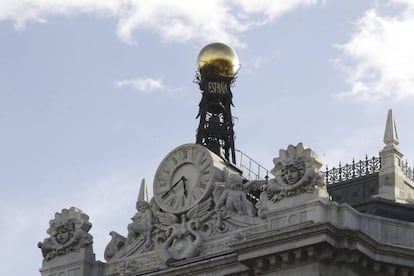Spain’s public debt grows further, hitting highest level since 1909
After taking on another €18 billion, the country’s ratio of borrowing now stands at 100.9% of GDP

Spain’s public debt rose in June by €18.549 billion, reaching a total of €1.107 trillion, the highest figure ever in absolute terms. As a percentage of GDP, the ratio of the country’s debt comes in at 100.9%, a record figure that even exceeds the 100.5% seen in March, which was when the ratio broke the 100% barrier for the first time.
Such a figure has not been seen since 1909, when, according to records, debt levels reached 102% of GDP.
Sources from the Economy Ministry say that the figures must be put into the context of the debt calendar
Sources at the Economy Ministry say that the figures must be put into the context of the debt calendar, which can see peaks and troughs due to the differences between emission and repayment dates. The main maturity dates come in January, April, July and October.
Once these factors are taken into account, the ministry says, the country’s growth is seen to be continuing the deceleration that began in 2013, and as such will achieve the target of 99.1% set out in the stability program by the end of 2016. That’s to say, the expected growth in GDP for this year, which will dilute the percentage, should bring the figure down for the second year in a row.
However, the European Commission does not believe that the government will manage to bring the debt ratio down this year. According to its forecasts, it believes that Spain will end the year with debt levels of 100.3% of GDP. But the Economy Ministry insists that the historically low cost of borrowing makes the debt levels sustainable. The intervention of the European Central Bank in the markets has in large part made this situation possible.
Spain’s public debt has seen unstoppable rises since 2009. That year it reached 52.7% of GDP, compared to 39.4% just a year before. It continued to notch up percentage points at a huge speed until it passed the 90% barrier in 2013. That year, in March, it passed the 100% barrier for the first time in more than a century. April saw the ratio ease somewhat, but in May and June it picked up pace once more.
Sign up for our newsletter
EL PAÍS English Edition has launched a weekly newsletter. Sign up today to receive a selection of our best stories in your inbox every Saturday morning. For full details about how to subscribe, click here
English version by Simon Hunter.
Tu suscripción se está usando en otro dispositivo
¿Quieres añadir otro usuario a tu suscripción?
Si continúas leyendo en este dispositivo, no se podrá leer en el otro.
FlechaTu suscripción se está usando en otro dispositivo y solo puedes acceder a EL PAÍS desde un dispositivo a la vez.
Si quieres compartir tu cuenta, cambia tu suscripción a la modalidad Premium, así podrás añadir otro usuario. Cada uno accederá con su propia cuenta de email, lo que os permitirá personalizar vuestra experiencia en EL PAÍS.
¿Tienes una suscripción de empresa? Accede aquí para contratar más cuentas.
En el caso de no saber quién está usando tu cuenta, te recomendamos cambiar tu contraseña aquí.
Si decides continuar compartiendo tu cuenta, este mensaje se mostrará en tu dispositivo y en el de la otra persona que está usando tu cuenta de forma indefinida, afectando a tu experiencia de lectura. Puedes consultar aquí los términos y condiciones de la suscripción digital.
Últimas noticias
Most viewed
- Why we lost the habit of sleeping in two segments and how that changed our sense of time
- Charles Dubouloz, mountaineering star, retires at 36 with a farewell tour inspired by Walter Bonatti
- Venezuela faces its most tense Christmas yet
- CBS in crisis after pulling a report on Trump’s deportations to El Salvador (which later leaked online)
- Bukele clan fumes over investigation exposing their new wealth









































